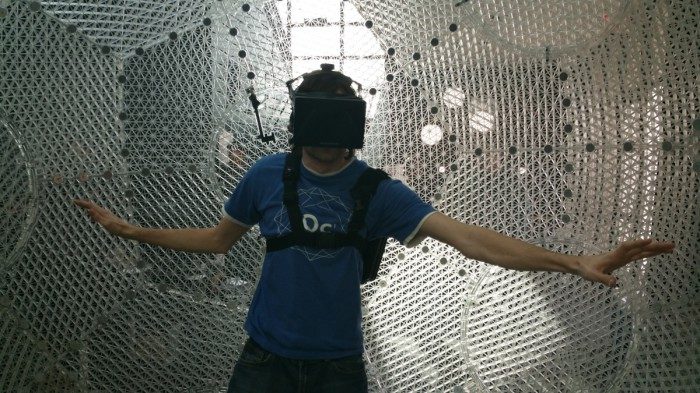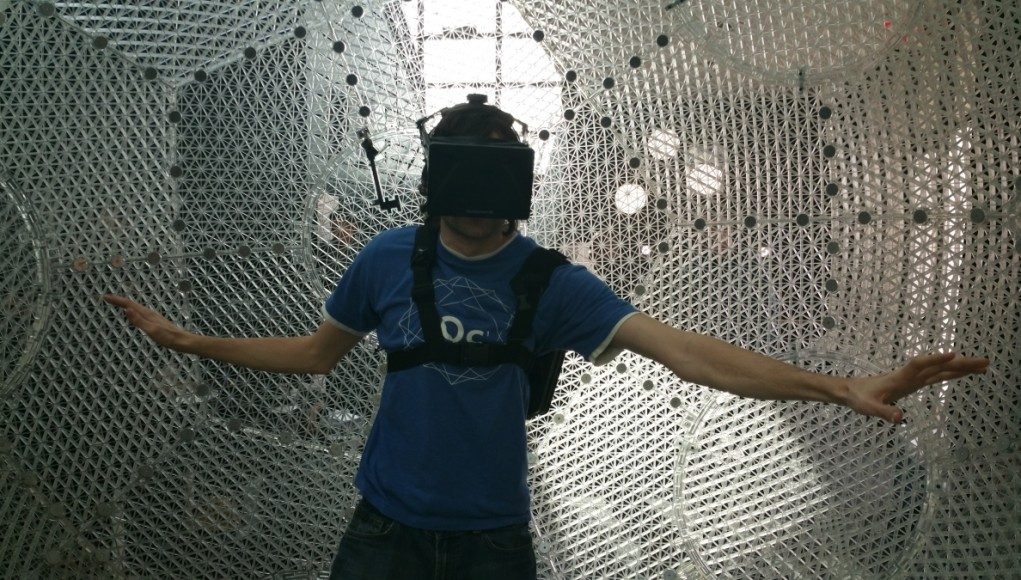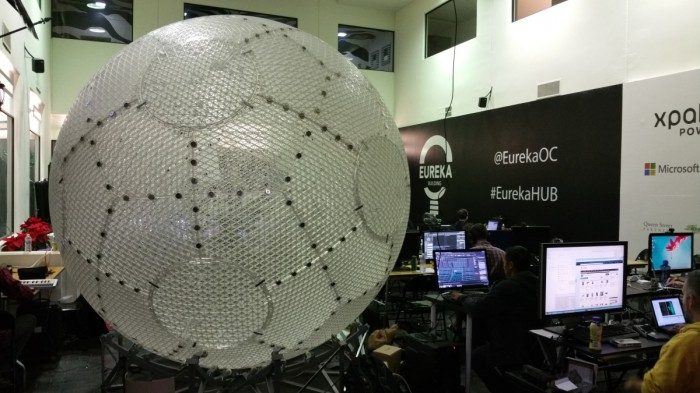
During a recent virtual reality hackathon at OCVR, I was able to try out a crazy contraption called the Virtusphere—essentially a giant acrylic human hamster ball that lets the user feel like they are walking through a virtual world. It was an intense and exciting experience that I will never forget.
When it comes to virtual reality, the whole idea is to initiate the feeling of Presence, the feeling of actually stepping deep inside a virtual world. When mismatches happen between what your brain expects and what it actually feels the feeling of Presense can be broken. This leaves behind a sense of disappointment along with being disassociated from the VR landscape.
In order to combat the fact that your body is somewhere different (the real world) than what your eyes are seeing (the virtual world), several companies have been working to create locomotion devices that allow freedom of movement within virtual worlds. Examples include the multi-directional treadmill known as the Virtuix Omni, as well as this huge plastic ball called the Virtusphere.
See also: Virtuix Closes $2.7M Investment, Finalized Omni Design to be Revealed at CES 2015
The Virtusphere is nothing new. It’s been around for years and several online news publications like Vice, CNN, Engadget, Popular Science, and Wired have all picked it up before. However, with the recent advancements of virtual reality and the sudden release of the Oculus Rift development kits, interests in this hamster ball-like system has fired up once again.
But why did it show up in Orange County during an unassuming weekend? Why here, and why now?
The answers to these questions can be understood by first looking at the growing movement of VR in Southern California. Around the same time that Facebook acquired Oculus, virtual reality meetups were starting to form in the area. At first, VRLA popped up and began aggregating consumer interest by setting up exciting events bringing in the general public and introducing them to VR for the very first time. Then shortly after the initial VRLA meetup, a second organization sprung up looking to gather up the virtual reality developers and inspiring them towards creating new ideas with virtual reality experiences as a base.
That developer focused meetup calls themselves OCVR, which was started by a handful of guys including Dylan Watkins, Michel Haddad, Matt Kinney, Kendrick Parks, and a few others. Interestingly enough a couple of those co-founders were running a food truck called Burger Monster at the same time and were attracting hungry developers with promises of fantastic food as well as high-tech prizes. Soon dozens upon dozens of developers were streaming through the door looking to find like minded individuals to team up with.
When asked what OCVR is about, Dylan Watkins described it as “a nexus place for local developers to give them the tools that they need, to give them the equipment, to give them the training, to give them the knowledge, and allow them to make whatever experiences they want.” This would include giving developers access to high speed internet, a place to hack for hours on end, computers if needed, a variety of VR technologies, and of course plenty of nourishment.
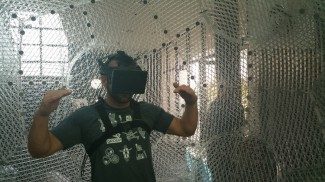
At the group’s 5th hackathon, which happened to be OCVR’s biggest one yet, approximately 30+ developers showed up to an incubator space, called the Eureka Building throughout the weekend, ready to start coding away. One of the guys who heard about the event beforehand, Michael Douglas, was interested in bringing something that developers like himself could use. That device was the 10ft spherical human hamster wheel called the Virtusphere.
Originally, there were concerns that it might be too much of an effort to get up and running, but Michael Douglas and the OCVR guys stood up the challenge and got it in the door. Granted, it took two whole days to finally get it going, but the outcome was worth the time.
Once the plastic pieces were fit together and the ball was positioned on the rolling wheels which held the sphere in place, people at the hackathon could get inside and test it out. There was even one guy who slept in it one night around 3am. Not sure how his back was after that, but the story will remain as a legend in the VR hackathon world.
The first person to try out the working Virtusphere was obviously Dylan Watkins who eagerly led the way, bravely stepping into uncharted virtual reality territory. Only Michael Douglas had used it before that, so he made the necessary precautions to keep people safe while they were inside.
After a couple of others took their turn, I climbed in ready to give it a go.
The first step was getting inside. That took a little bit of effort in that the whole Virtusphere had to be rotated allowing for one particular entranceway to be positioned just right. The opening was barely enough to get into and felt like journeying through a tight crawlspace which led to the inside of the sphere.
Once I stood up, it was like looking through a force field that kept me safe from the outer world. I could see everyone outside working diligently on their VR programs beyond the plastic grid surface. The pattern was mesmerizing; the whole thing was made up of tiny triangles that would join to form larger hexagons which in turn made even larger shapes. Metal circles screwed in strategic places held each segment together to form an entire sphere. I could extend my arms all the way out and there was plenty of room to move around. From there the speed would pick up as the large plastic ball began to rotate on its wheels.
Another journalist named Ian Hamilton showed up and captured a short video showing what it is like to be inside while others joyfully watched from the outside.
Being that I am known for pushing the boundaries in every which way, I had the urge to run as fast as I could while blindly wearing an Oculus DK1 on my face. Sure, I could see a virtual world in front of me, but my feet felt out of place as I was sprinting up against a curved surface instead of feeling flat ground in front of me.
Eventually I hit the ground bringing my hands falling to the plastic floor as my world turned upside down. Luckily Michael Douglas was there to slow the Virtusphere down to a steady pace, allowing me to catch my breath.
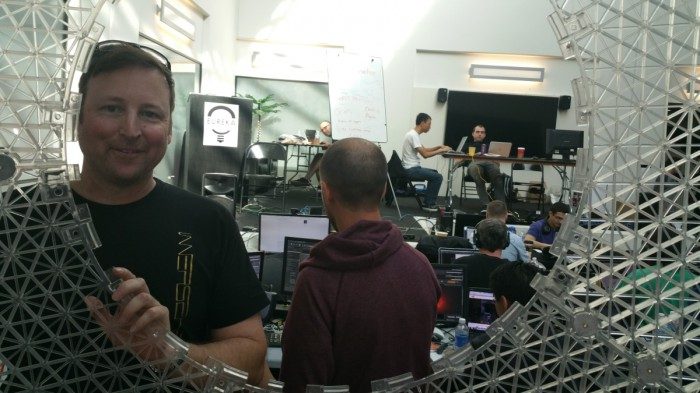
After hitting the ground moving quite fast, I can see how easy it would be to get injured with something like this. It was clear to why Douglas insisted on people wearing shoes while inside.
Still, the experience was out of this world. The demo that was loaded up was the Tuscany VR experience and it felt like I was floating in a sphere as it moved through the virtual landscape. The IR sensor system below my feet tracked the movements of my body and the information was passed wirelessly to a computer outside the Virtusphere. The backpack that I wore sent additional data to that computer as well, and it powered the DK1 headset as I ran from place to place.
It felt like being in a bubble gliding through a virtual realm in that my feet never hit the computer simulated ground. At times, there was a sense of being blocked from the environment because my body could sense that there was something in the way of me. Yet, at the same time it was like the Virtusphere itself was transported into that artificial world, making its presence known through contact with the shoes that I wore below. I could tell that there was an invisible layer that lay between me and the virtual environment.
As my Virtusphere ‘vehicle’ moved through the simulation, my sense of direction would occasionally shift suddenly due to my brain attempting to sync up the circular physical surroundings to the flat computer generated imagery at the edges of my toes. This made it difficult to transverse about as it was like trying to walk on a boat while waves rocked the deck. It was similar to what people call ‘sea legs’, and took a few jostling moments to get used to it, but eventually I figured out how to move around comfortably.
Regardless of the experience, a challenge facing the Virtusphere is its unsuitability for the home. It’s just too big to be practical for in-home use. However, with the spread of VR, it could find itself a comfortable addition to arcades, amusement parks, conferences, and even VR hackathons.
What comes next for this specific Virtusphere will be experimentation with Samsung mobile Gear VR headset, which the OCVR co-founders eagerly told me that they are going to try right away. Once they get it rolling, I will surely strap on some padded gloves and knee protectors, and see just how far I can go.
